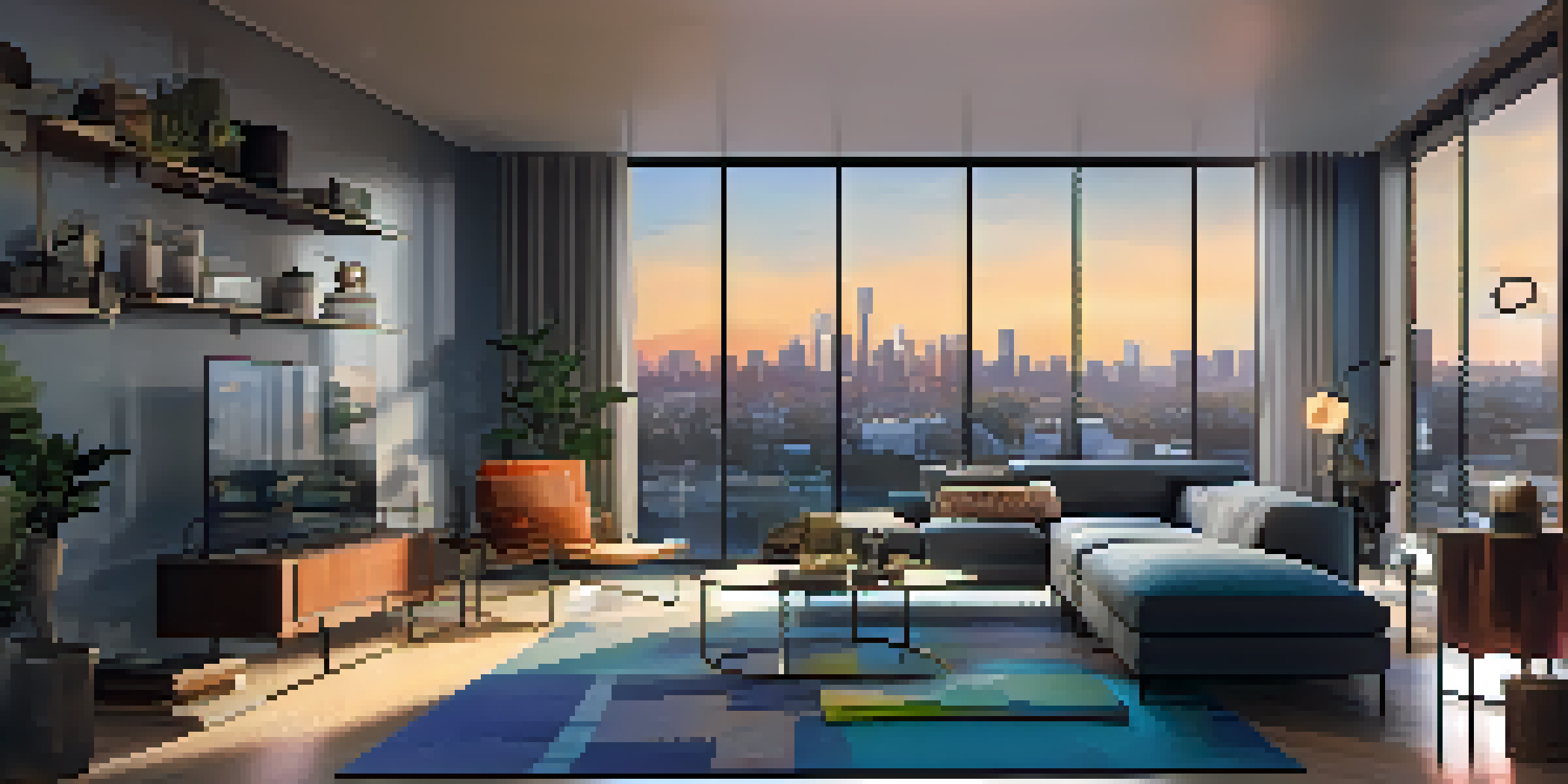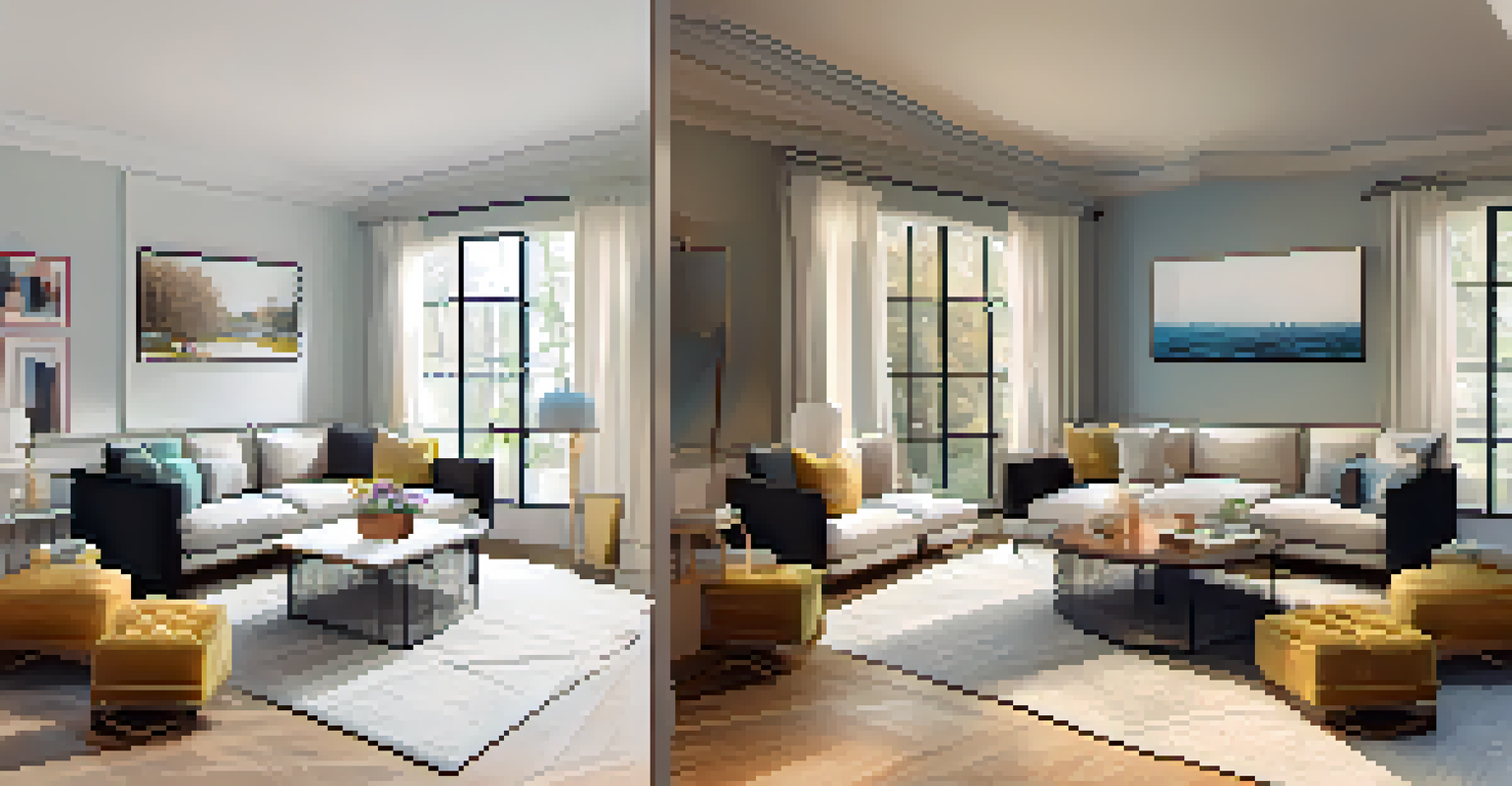The Role of Virtual Reality in Modern Home Staging Practices

What is Virtual Reality in Home Staging?
Virtual reality (VR) in home staging involves using advanced technology to create immersive 3D environments that potential buyers can explore. Instead of traditional staging, which requires physical changes to a space, VR allows real estate agents to showcase properties digitally. This innovative approach not only saves time and resources but also captivates buyers by providing an interactive experience.
Virtual reality is not just a tool; it's a new way of experiencing the world and understanding our place in it.
Imagine walking through a beautifully staged living room without ever setting foot inside the actual house. With VR, clients can visualize different layouts, decor styles, and even furniture arrangements. This level of engagement is far more impactful than simply looking at photos on a listing, as it allows buyers to connect emotionally with the space.
As the real estate market becomes increasingly competitive, utilizing VR technology can set agents apart. The ability to present homes in an engaging way not only attracts more interest but also leads to quicker sales, making it a valuable tool for modern home staging.
Benefits of Using VR in Home Staging
The benefits of using virtual reality in home staging are numerous and compelling. First, VR reduces the need for physical staging, which can be expensive and time-consuming. Agents can create a virtual tour in a fraction of the time, allowing them to showcase multiple properties efficiently without the hassle of moving furniture.

Additionally, VR allows for broader audience reach. Buyers can view properties remotely, making it easier for out-of-town or international clients to explore homes at their convenience. This accessibility enhances the chances of finding a buyer, as it accommodates various schedules and locations.
VR Transforms Home Staging
Virtual reality creates immersive 3D environments that allow potential buyers to explore properties without physical staging.
Moreover, VR can enhance a buyer's decision-making process. By visualizing spaces accurately, clients can feel more confident in their choices, leading to faster offers and fewer second-guessing moments. It's a win-win for both buyers and sellers!
How VR Enhances Buyer Experience
Virtual reality elevates the buyer experience by offering a sense of presence that traditional photos can't match. When buyers don VR headsets, they are transported into a lifelike representation of the home, allowing them to explore every nook and cranny as if they were actually there. This immersive experience can evoke emotions and help buyers envision their future in the space.
The future of real estate is digital, and virtual reality will play a significant role in enhancing how buyers interact with properties.
For instance, prospective homeowners can visualize family gatherings in the dining room or picture themselves relaxing in a cozy living room. This emotional connection is crucial; it often influences their willingness to make an offer. In essence, VR transforms a property viewing into an engaging story, helping buyers imagine their lives unfolding within those walls.
Furthermore, VR can also provide customization options, allowing buyers to modify colors, furniture styles, or layouts in real time. This personalization makes the experience even more engaging, as it empowers clients to see the potential of the space tailored to their tastes.
The Technology Behind VR Home Staging
The technology behind virtual reality home staging involves a combination of 3D modeling software and VR hardware. 3D models of homes are created, which can be rendered into a virtual environment that users can navigate. This process requires skilled designers to accurately represent the property while ensuring that it remains visually appealing.
Once the 3D model is ready, it can be integrated with VR platforms, such as Oculus Rift or HTC Vive, which allow users to immerse themselves in the virtual space. These devices provide an interactive experience, using motion sensors and controllers to navigate the environment seamlessly.
Broader Audience Reach with VR
Using VR enables remote property viewing, making it easier for out-of-town clients to explore homes at their convenience.
Moreover, advancements in augmented reality (AR) are also complementing VR in home staging. For example, AR applications can overlay virtual furniture in real spaces through a smartphone camera, allowing buyers to see how a room might look with specific items. This blend of technologies offers even greater flexibility and creativity in showcasing properties.
Case Studies: Successful Use of VR in Home Staging
Numerous real estate agencies have successfully incorporated virtual reality into their home staging practices, resulting in impressive outcomes. For instance, a prominent agency in California reported a 30% increase in inquiries for properties that featured virtual tours. This success can be attributed to the engaging nature of VR, which allows potential buyers to explore homes from the comfort of their own space.
Another notable case involved a luxury property that struggled to attract interest. By implementing a VR staging strategy, the agency created an immersive experience that highlighted the property's unique features. As a result, they received multiple offers within a week, showcasing the potential of VR to re-energize stagnant listings.
These case studies demonstrate that when used effectively, virtual reality can significantly enhance the appeal of a property. It not only attracts more attention but also facilitates quicker sales, making it a powerful tool in the modern home staging toolkit.
Challenges of Implementing VR in Home Staging
While the benefits of virtual reality in home staging are clear, there are challenges to consider as well. One major hurdle is the initial investment in technology and training. Real estate agents may need to purchase VR equipment and software, which can be a significant upfront cost, especially for smaller agencies.
Additionally, creating high-quality virtual staging requires expertise in 3D design and modeling. This means agencies may need to hire specialized professionals or invest time in training existing staff. Balancing these costs with the potential return on investment can be a delicate task.
Future of VR in Real Estate
Advancements in VR technology promise more realistic experiences and personalized staging recommendations for buyers.
Moreover, not all clients may be comfortable with technology, which can limit the reach of VR staging. It's important for agents to provide guidance and support to clients unfamiliar with VR to ensure they can fully enjoy the immersive experience it offers.
The Future of VR in Home Staging
As technology continues to advance, the future of virtual reality in home staging looks promising. We can expect to see even more realistic and interactive experiences, with improvements in graphics and user interface design. This evolution will further enhance the ability of buyers to visualize their future homes, making the process even more engaging.
Moreover, the integration of artificial intelligence (AI) with VR could lead to personalized staging recommendations based on buyer preferences. Imagine a scenario where a virtual assistant curates a home tour that highlights features specifically suited to an individual buyer's taste. This level of personalization could revolutionize the home buying experience.

Ultimately, as more real estate professionals adopt VR technologies, it will likely become a standard practice in home staging. This shift not only benefits sellers and agents but also enhances the overall experience for buyers, making the journey towards finding a dream home more enjoyable and efficient.